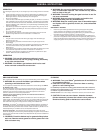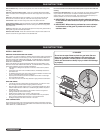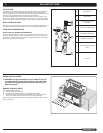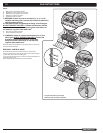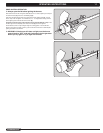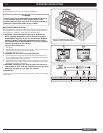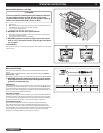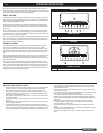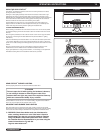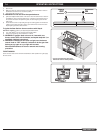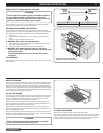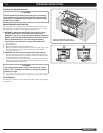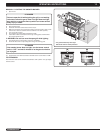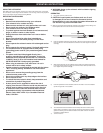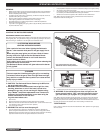Special offers from our partners!

Find Replacement BBQ Parts for 20,308 Models. Repair your BBQ today.

Buy Weber Grill Parts. It couldn't be easier. Find your Weber parts here.

14
www.weber.com
®
operatinG instructions
GRILLING TIPS & HELPFUL HINTS
• Alwayspreheatthegrillbeforecooking.Setallburnerson“HI”heatandcloselid;
heatfor10minutes,oruntilthermometerregisters500˚-550˚F(260˚-288˚C).
• Searmeatsandcookwiththeliddownforperfectlygrilledfoodeverytime.
• Grillingtimesinrecipesarebasedon70˚F(20˚C)weatherandlittleornowind.
Allow more cooking time on cold or windy days, or at higher altitudes. Allow less
cooking time in extremely hot weather.
• Grillingtimescanvarybecauseoftheweather,ortheamount,sizeandshapeof
the food being grilled.
• ThetemperatureofyourSummit
®
gas grill may run hotter than normal for the first
few uses.
• Grillingconditionsmayrequiretheadjustmentoftheburnercontrolstoattainthe
correct cooking temperatures.
• Ingeneral,largepiecesofmeatwillrequiremorecookingtimeperpoundthan
small pieces of meat. Foods on a crowded cooking grate will require more cooking
time than just a few foods. Foods grilled in containers, such as baked beans, will
require more time if grilled in a deep casserole rather than a shallow baking pan.
• Trimexcessfatfromsteaks,chopsandroasts,leavingnomorethanascant¼
inch (6.4mm) of fat. Less fat makes cleanup easier, and is a virtual guarantee
against unwanted flare-ups.
• Foodsplacedonthecookinggratedirectlyaboveburnersmayrequireturningor
moving to a less hot area.
• Usetongsratherthanaforkforturningandhandlingmeatstoavoidlosingnatural
juices. Use two spatulas for handling large whole fish.
• Ifanunwantedflare-upshouldoccur,turnallburnersoffandmovefoodto
another area of the cooking grate. Any flames will quickly subside. After flames
subside, relight the grill. NEVER USE WATER TO EXTINGUISH FLAMES ON A
GAS GRILL.
• Somefoods,suchasacasseroleorthinfishfillets,willrequireacontainer
for grilling. Disposable foil pans are very convenient, but any metal pan with
ovenproof handles can also be used.
• Alwaysbesurethebottomtrayandgreasecatchpanarecleanandfreefrom
debris.
• Donotlinethefunnel-shapedbottomtraywithfoil.Thiscouldpreventthegrease
from flowing into the grease catch pan.
• Usingatimerwillhelptoalertyouwhen“well-done”isabouttobecome“over-
done.”
The most important thing to know about grilling is which cooking method to use for a
specific food, Direct or Indirect. The difference is simple: place the food directly over the
fire, or arrange the fire on either side of it. Using the right method is the shortest route to
great results—and the best way to ensure doneness safety.
DIRECT COOKING
The Direct Method, similar to broiling, means the food is cooked directly over the heat
source. For even cooking, food should be turned once halfway through the grilling time.
Use the Direct method for foods that take less than 25 minutes to cook: steaks, chops,
kabobs, sausages, vegetables, and more.
Direct cooking is also necessary to sear meats. Searing creates that wonderful crisp,
caramelized texture where the food hits the grate. It also adds great color and flavor to
the entire surface. Steaks, chops, chicken breasts, and larger cuts of meat all benefit
from searing.
To sear meats, place them over Direct High heat for 2 to 5 minutes per side. Smaller
pieces require less searing time. Usually after searing you finish cooking the food at a
lower temperature. You can finish cooking fast-cooking foods by the Direct method; use
the Indirect method for longer-cooking foods.
To set up your gas grill for Direct cooking, preheat the grill with all burners on “HI”. Place
food on the cooking grate, and then adjust all burners to the temperature noted in the
recipe. Close the lid of the grill and lift it only to turn food or to test for doneness at the
end of the recommended cooking time.
INDIRECT COOKING
The Indirect Method is similar to roasting, but with the added benefits of that grilled
texture, flavor, and appearance you can’t get from an oven. To set up for Indirect
cooking, gas burners are lit on either side of the food but not directly beneath it. Heat
rises, reflects off the lid and inside surfaces of the grill, and circulates to slowly cook the
food evenly on all sides, much like a convection oven, so there’s no need to turn the
food.
Use the Indirect method for foods that require 25 minutes or more of grilling time or that
are so delicate that direct exposure to the flame would dry them out or scorch them.
Examples include roasts, ribs, whole chickens, turkeys, and other large cuts of meat, as
well as delicate fish fillets.
To set up your gas grill for Indirect cooking, preheat the grill with all burners on “HI”.
Then adjust the burners on each side of the food to the temperature noted in the recipe
and turn off the burner(s) directly below the food. For best results, place roasts, poultry,
or large cuts of meat on a roasting rack set inside a disposable heavy-gauge foil pan.
For longer cooking times, add water to the foil pan to keep drippings from burning. The
drippings can be used to make gravies or sauces.
6 BURNER
12
3
45
6
DIRECT METHOD
A
Food is placed on the area of the cooking grates directly over the lit
burners
6 BURNER
12
3
56
4
INDIRECT METHOD
B
Food is placed on the area of the cooking grates between the lit burners



